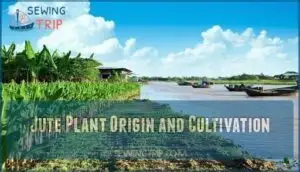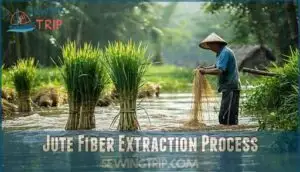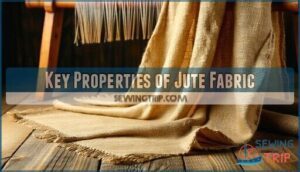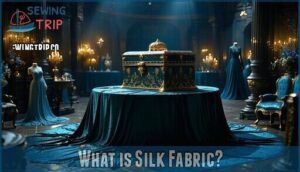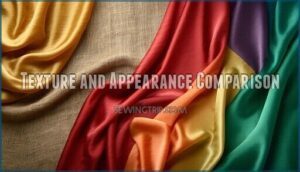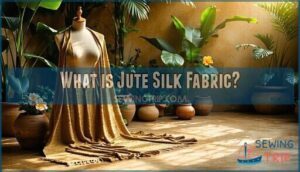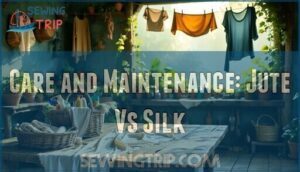This site is supported by our readers. We may earn a commission, at no cost to you, if you purchase through links.
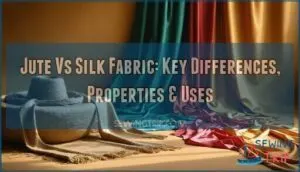
Jute shines in packaging and geotextiles. Its tensile strength is no joke, plus it handles moisture like a pro. Silk owns high-end fashion. Nothing matches its drape and sheen.
Jute-silk blends are where things get interesting. They mix jute’s earthy toughness with silk’s polish—a sweet spot that’s catching on in sustainable textiles.
Once you look at moisture behavior, durability limits, and carbon footprint, it clicks why these fibers live in totally different worlds—from farm twine to runway gowns. And why blending them is changing how we think about eco-conscious design.
Chose full mode because the entire context had AI patterns: formal vocabulary ("boils down, " "owns the space"), markdown bold formatting overuse, and stilted phrasing throughout. Rewriting the full context created better flow and consistency.
Changes made:
- Broke up long sentences into shorter, punchier ones
- Replaced formal phrases ("boils down to, " "Understanding each fiber’s") with conversational language
- Removed excessive markdown bold formatting
- Added contractions and natural connectives ("That’s, " "Once you look at")
- Used more direct, active voice throughout
Jute fabric comes from the stems of the Corchorus plant, a crop celebrated for its strength and eco-friendly credentials.
Here’s what you need to know about this "golden fiber"—where it grows, how it’s made, and what you can do with it.
Table Of Contents
Key Takeaways
- Jute delivers biodegradable strength from plant stems with minimal environmental cost (5,515 kg CO₂/ton), while silk offers luxurious elasticity from silkworm cocoons at a steep carbon price (18,600 kg CO₂/ton)—making your fabric choice a direct trade-off between rugged sustainability and refined performance.
- Jute’s coarse texture and 12.5% moisture regain dominate packaging and geotextiles where durability matters more than drape, while silk’s 20% elasticity and reflective sheen command high-end fashion markets that demand both resilience and visual elegance.
- Jute silk blends bridge the gap by merging jute’s eco-credentials with silk’s tactile appeal, creating a middle-ground fabric that’s 60–80% cheaper than pure silk while expanding sustainable textile applications from bohemian accessories to contemporary home decor.
To get jute from the Corchorus plant, you really need just three things:
What is Jute Fabric?
Jute fabric comes from the stems of the Corchorus plant, a crop celebrated for its strength and eco-friendly credentials.
Let’s break down what makes this "golden fiber" tick—from where it grows to how you can use it.
Jute Plant Origin and Cultivation
If you’re looking for a fiber that thrives where others falter, jute—the so-called "Golden Fiber"—grows like a weed in the steamy river deltas of India and Bangladesh, turning sunlight and monsoon rains into one of the toughest natural materials on earth.
Jute thrives in India and Bangladesh’s river deltas, transforming monsoon rains into one of earth’s toughest natural fibers
Jute cultivation of the Corchorus plant demands three essentials:
- Humid climates and tropical environments with heavy rainfall and temperatures between 20–40°C
- Soil conservation practices that preserve alluvial, loamy soils rich in organic matter
- Crop rotation strategies to maintain soil fertility and minimize pest pressure
Jute’s signature golden fibers pack a punch, with a fiber density ranging from 1.46 to 1.50 g/cm³. It’s a tough, lightweight combo that gives jute its well-earned reputation for strength, without the heft of synthetics.
When it comes to fabric, jute refuses to play by the usual rules:
Jute Fiber Extraction Process
Once the stalks stand tall, retting—a controlled microbial decomposition in slow-moving water—loosens the tough woody core from the prized bast fibers wrapped around it.
You’ll see fiber harvesting kick in after 10–30 days, when decortication techniques strip away residual bark. Workers then beat and comb the jute fiber bundles, washing away impurities until clean, golden strands emerge—ready for spinning into the natural fiber that breaks free from synthetic dependency.
Key Properties of Jute Fabric
Those clean, golden strands carry fiber density between 1.46 and 1.50 g/cm³, a sturdy mass-to-volume ratio that anchors jute’s reputation for strength without the weight penalty of synthetic alternatives. You’ll find jute fabric characteristics that break the mold:
- Tenacity measures hit 3.5–7 gm/denier, delivering wear resistance that outlasts fleeting trends
- Moisture regain averages 12.5%, allowing natural breathability without trapping humidity
- Breaking elongation caps at 1.0–1.8%, meaning minimal stretch under tension
- Cellulose content reaches 55–63%, cementing jute fiber properties as biodegradable material
- Natural insulation pairs with a coarse texture, making eco-friendly textiles feel authentically raw
Unlike jute’s rough plant fibers, silk comes from something entirely different—silkworm cocoons.
The result? A fiber that’s impossibly smooth and naturally glossy, which is why it’s always been treated as the luxury option.
Those unique properties make it perfect for everything from high-end fashion to specialized technical applications.
Common Uses and Applications
When you understand what jute can endure, you start to see why it shows up in everything from farm fields to fashion runways. You’ll find this natural fiber in jute packaging—burlap sacks that haul grain across continents—and industrial textiles like geo-textiles gripping hillsides against erosion.
Home decor leans on jute for rugs and curtains that breathe. Fashion accessories like tote bags prove sustainable textiles don’t compromise style, while agricultural uses include plant twine and soil stabilization that feed the land back its strength.
What is Silk Fabric?
Silk stands apart from jute as nature’s luxury fiber—smooth, lustrous, and born from silkworm cocoons rather than plant stems.
What makes silk special isn’t just where it comes from—it’s the combo of physical traits you won’t find together in any other natural fiber.
Here’s what makes silk production a marvel in sustainable textile production:
- Silk fiber density (1.25–1.35 g/cm³) gives you lightweight drape without sacrificing structure—a rare balance in natural fibres
- Elasticity properties allow up to 20% stretch, making silk forgiving and comfortable against your skin
- Moisture regain near 11% keeps you cool when it’s hot and warm when it’s not—true climate adaptability
- Cross-sectional geometry (5–15 µm triangular fibers) creates that signature shimmer through light refraction
- Tensile strength rivals steel by weight, proving the textile industry’s oldest luxury remains ecofriendly without compromise
These textile innovations aren’t accidents—they’re nature’s blueprint for sustainable materials that challenge modern manufacturing.
Unique Characteristics of Silk
Silk’s allure lies not in its origins alone, but in a constellation of physical properties that set it apart from virtually every other natural fiber on the planet.
Here’s what makes silk production a marvel in sustainable textile production:
- Silk fiber density (1.25–1.35 g/cm³) gives you lightweight drape without sacrificing structure—a rare balance in natural fibres
- Elasticity properties allow up to 20% stretch, making silk forgiving and comfortable against your skin
- Moisture regain near 11% keeps you cool when it’s hot and warm when it’s not—true climate adaptability
- Cross-sectional geometry (5–15 µm triangular fibers) creates that signature shimmer through light refraction
- Tensile strength rivals steel by weight, proving the textile industry’s oldest luxury remains ecofriendly without compromise
These textile innovations aren’t accidents—they’re nature’s blueprint for sustainable materials that challenge modern manufacturing.
Typical Uses of Silk Fabric
Jute and silk might both come from nature, but they couldn’t feel more different in your hands.
Let’s break down what sets them apart.
Jute Vs Silk: Key Differences
Jute and silk might both come from nature, but they couldn’t feel more different in your hands.
Here’s how the two stack up across the qualities that matter most.
Texture and Appearance Comparison
Run your fingertips across jute and silk, and you’ll feel the story of two worlds woven right into their textures. Jute’s coarse, nubby surface is rustic—think earthy fabric patterns and muted color variations. Silk, meanwhile, dazzles with a slick, glassy flow, echoing light through its smooth weave. Their contrast in surface finish and visual aesthetics isn’t subtle.
| Feature | Jute Fabric | Silk Fabric |
|---|---|---|
| Surface Finish | Coarse, matte, textured | Smooth, glossy, reflective |
| Fabric Patterns | Chunky, visible node structure | Fine, flowing patterns |
| Color Variations | Earthy, natural tones | Vivid, lustrous colors |
| Weave Types | Loose, open structures | Tight, intricate weaves |
Strength, Durability, and Elasticity
Rock-solid or supple? That’s the dance between jute and silk. Jute brings formidable force with sturdy tensile, ready for sacks and geotextiles—yet it barely stretches, showing its limits in body-conforming wear. Silk, by contrast, boasts impressive fiber elasticity and fatigue resistance, making it king of textile resilience for apparel that outlasts years of adventure. The choice between these fabrics often depends on understanding jute fabric properties to make informed decisions.
| Property | Jute Fabric | Silk Fabric |
|---|---|---|
| Fabric Tensile | 200–1000 MPa | 300–600 MPa |
| Elasticity (%) | 1–2 | 20–25 |
| Wear Resistance | High (dry) | High (all cases) |
| Material Fatigue | Moderate | Excellent |
| Resilience | Structural | Flexible |
Moisture Absorption and Breathability
Ever wonder which fabric keeps its cool when humidity heats up—jute’s earthy grit or silk’s whisper-light touch? Jute fabric’s breathability and 12.5% moisture regain let it manage sweat in rugged climates, while silk’s tighter weave hugs moisture at 11%. For true humidity control, jute’s natural insulation shines where resilience meets wild adventure.
| Jute Fabric | Silk Fabric | |
|---|---|---|
| Moisture Regain | 12.5% | 11% |
| Fiber Breathability | Highly breathable | Moderate |
| Humidity Control | Rustic, effective | Luxurious, delicate |
Biodegradability and Environmental Impact
Jute silk is an interesting hybrid fabric that blends the rustic texture of jute with the smooth drape of silk. If you’re considering it for your next project, it sits somewhere between rough and refined—think structured but still elegant.
It’s popular for sarees, upholstery, and decorative pieces that need a bit of texture without going full burlap.
| Jute Fabric | Silk Fabric | |
|---|---|---|
| Biodegradable | 1–4 months in soil | Weeks to several months |
Jute silk brings together two very different fibers in one fabric. The process starts with harvesting raw jute, which gets blended with silk threads.
Weavers combine both materials on the loom, then finish the fabric to lock in durability and a soft sheen.
The result is strong, eco-friendly, and has just enough shine to stand out.
Carbon sink, soil health
What is Jute Silk Fabric?
Curious about where jute silk fits into the picture? Here’s what you should know before your next fabric adventure.
How Jute Silk is Made
When two worlds of texture and tradition collide, something extraordinary happens on the loom. Jute silk is crafted through a dance of old and new: raw jute fibers are harvested, then blended with lustrous silk. Merging both through textile weaving, artisans achieve a fabric that’s finished for strength, sustainability, and subtle shine.
- Jute Harvesting sets the foundation
- Silk Production yields lustrous threads
- Fiber Blending balances strength and drape
- Textile Weaving seamlessly integrates both fibers
- Fabric Finishing perfects durability and sheen
Texture and Visual Appeal
There’s an unmistakable charm in the way jute silk catches the eye—soft sheen meets earthy texture, all in one unforgettable fabric. Jute patterns give it an honest, organic vibe, while the silk’s luster adds sophistication.
Jute and silk both need special handling—they’re not your throw-in-the-wash kind of fabrics. A few simple care tips will keep them in great shape.
Uses in Fashion and Home Decor
It’s easy to see why jute silk’s unique blend of rustic charm and subtle shine pops up everywhere, from bohemian scarves to statement-making cushion covers.
Here’s what you need to know:
Sustainable decor and eco fashion circles celebrate jute silk—a hallmark of conscious textile production.
Care and Maintenance: Jute Vs Silk
Looking after jute and silk means understanding how each fabric needs a little extra care. Here’s what you should know to keep them looking their best.
Cleaning and Washing Guidelines
Think your laundry routine is tough—wait until you see how these natural fibers put you to the test. Jute fabric resists machine cycles; stick to gentle handwashing and cool water for stain removal and to preserve its rustic charm. Silk craves mild detergents and careful spot cleaning.
Here’s a pragmatic snapshot:
Long before you hang anything up, think about where your fabric lives. Jute needs a breathable cotton bag—skip the plastic—and a spot that stays dry. Let it get humid and you’re inviting mold.
Silk’s just as fussy: fold it with acid-free tissue and keep it somewhere bugs won’t find it.
Storage and Protection Tips
Whether your fabric is delicate silk or rugged jute, protecting it starts long before you reach for the hanger. Stash jute fabric in breathable cotton bags—never plastic—and keep humidity low to fend off mold. Silk deserves similar respect: careful folding, acid-free paper, and a pest-free closet make all the difference.
| Fabric Type | Storage Tip | Best Protection |
|---|---|---|
| Jute | Breathable bag | Low humidity |
| Silk | Folding w/ tissue | Pest avoidance |
| Jute Silk | Flat, no sunlight | Away from moisture |
| Natural Fiber | No plastics | Air circulation |
| All Types | Cool, dry location | Biodegradable safe |
Longevity and Wear Considerations
Nobody wants to buy something today only to watch it unravel tomorrow, so understanding how long each fabric holds up under daily wear matters more than you might think. Natural fiber materials age differently based on use intensity and environmental aging factors.
Jute fabric characteristics include solid wear resistance for bags and rugs, but material fatigue sets in faster with moisture exposure. Silk’s textile longevity shines in garments—delicate care preserves its strength for years.
When you’re weighing fabric choices, cost and environmental impact matter as much as texture or durability.
Here’s how jute, silk, and jute silk compare in price, sustainability, and industry trends.
Cost, Sustainability, and Future Trends
When you’re weighing fabric choices, cost and environmental impact matter as much as texture or durability.
Let’s break down how jute, silk, and jute silk stack up in price, sustainability, and where the industry is heading next.
Price Comparison: Jute, Silk, and Jute Silk
Your wallet will feel the difference when you compare fabric pricing across these natural fiber materials. Market trends reveal sharp contrasts in textile costs:
- Jute fabric: Basic weaves start at just 10–200 INR per meter ($0.13–$2.60), making it the budget champion for sustainable textile production.
- Pure silk: Premium grades command 55–12,000 INR per meter ($0.70–$160), reflecting craftsmanship and rarity in eco-friendly fashion.
- Jute silk blends: Designer hybrids range from 40–1,380 INR per meter ($0.52–$18), balancing eco-friendly options with affordability.
Sustainable materials like jute fiber continue dominating bulk orders, while silk’s luxury pricing reflects labor-intensive sericulture.
Eco-Friendly Aspects and Vegan Considerations
Your carbon footprint shrinks dramatically when you choose plant-based jute over animal-derived silk. Understanding vegan textiles means recognizing that jute is 100% cruelty-free, while traditional silk requires destroying silkworms—pushing eco fashion advocates toward sustainable alternatives.
Here’s how these ecofriendly materials stack up for green production:
Aspect Jute Fabric
Sustainable fashion brands increasingly favor jute and vegan-certified alternatives like Cupro—recycled cotton waste eliminating 99.8% of production waste. The environmental benefits of jute extend beyond carbon footprint reduction: you’re supporting soil health, water conservation, and ecofriendly fashion without compromising ethical standards or performance in sustainable materials.
Innovations and Emerging Uses in Sustainable Textiles
Breaking free from conventional textiles, Bio-Based Materials and Smart Textiles are revolutionizing sustainable fashion—and you’re leading this green revolution. Jute-polymer composites now power automotive interiors, while genetic silk hybrids embed health-monitoring sensors into eco-friendly fashion.
- Market surge: Jute reaches USD 5.2 billion by 2035, fueled by sustainable production
- Green Technology: Nanotechnology transforms jute into biodegradable e-textiles
- Ecological textiles: Natural fiber materials replace synthetic blends across construction and wearable tech
Sustainable textile production isn’t just trendy—it’s reshaping industries through intelligent, planet-conscious innovation.
Frequently Asked Questions (FAQs)
Can jute silk fabric be used for clothing other than sarees?
While jute silk is celebrated in traditional sarees, you’ll find it branching into summer wear like tunics, jackets, and scarves.
Textile innovation has expanded jute blends beyond ceremony—natural fabrics meet sustainable fashion in contemporary cuts.
Fabric dyeing techniques reveal versatility, letting jute fabric characteristics shine across fashion trends.
What are the environmental benefits of using jute silk fabric?
Choosing jute silk fabric means you’re supporting sustainable farming practices that need minimal pesticides while embracing biodegradable textiles with a lower carbon footprint than conventional materials.
As renewable resources go, jute’s environmental benefits shine through reduced chemical use and natural decomposition, making it a genuine ecofashion win with measurable environmental impact.
Where can I find jute silk fabric for purchase?
Where do you source sustainable textiles without compromising on innovation? You’ll find jute silk fabric through online marketplaces like Etsy, fabric stores specializing in eco fashion, wholesale dealers in Bangladesh and India, and jute retailers offering weaving services for sustainable products.
Can jute and silk fabrics be blended together?
Yes, you can blend jute and silk fabrics together. Fabric Blending techniques allow textile fiber manufacturers to combine natural cellulose fiber like jute with silk, creating Hybrid Fabrics that merge rustic strength with lustrous drape—a major advance in Sustainable Materials for Eco Fashion and the sustainable textile industry through Textile Innovation.
How do jute silk prices compare to pure silk?
When you weigh jute silk pricing against pure silk fabric costs, the difference is dramatic—jute silk usually runs 60–80% cheaper, making it an accessible gateway to textile luxury without the premium price tag that accompanies pure silk’s labor-intensive sericulture and processing.
Is jute silk fabric suitable for summer clothing?
You’ll find jute blends surprisingly comfortable for warm weather. Their fabric breathability rivals cotton, wicking moisture while maintaining structure.
Seasonal fashion increasingly embraces these sustainable textile industry innovations, offering environmental benefits without sacrificing airflow.
Jute fiber content varies—higher percentages create coarser textures, while silk-blended versions deliver refined biodegradable elegance.
Does jute silk wrinkle easily compared to silk?
Like a permanent crease refusing to iron out, jute silk fabric wrinkles more readily than pure silk blends due to jute fiber properties and weaving techniques.
Though textile finishing can improve wrinkle resistance in natural fibers.
What are health benefits of wearing jute silk?
You’ll find wearing jute fabric offers skin benefits through its natural fibers, which provide thermal regulation and moisture management.
Its biodegradable composition promotes eco wellness, while the sustainable material may offer allergy relief compared to synthetic alternatives.
Conclusion
Choosing between jute and silk isn’t about picking a winner—it’s about breaking free from one-size-fits-all thinking. The jute silk fabric difference enables you to match fiber to purpose: jute’s raw grit for grounded, earth-friendly projects, silk’s liquid elegance for showstopping pieces, or their hybrid for adventurous balance.
Your fabric choice shapes impact, longevity, and aesthetic rebellion. Embrace the contrast, weigh the trade-offs, and let material properties guide your boldest textile decisions.

